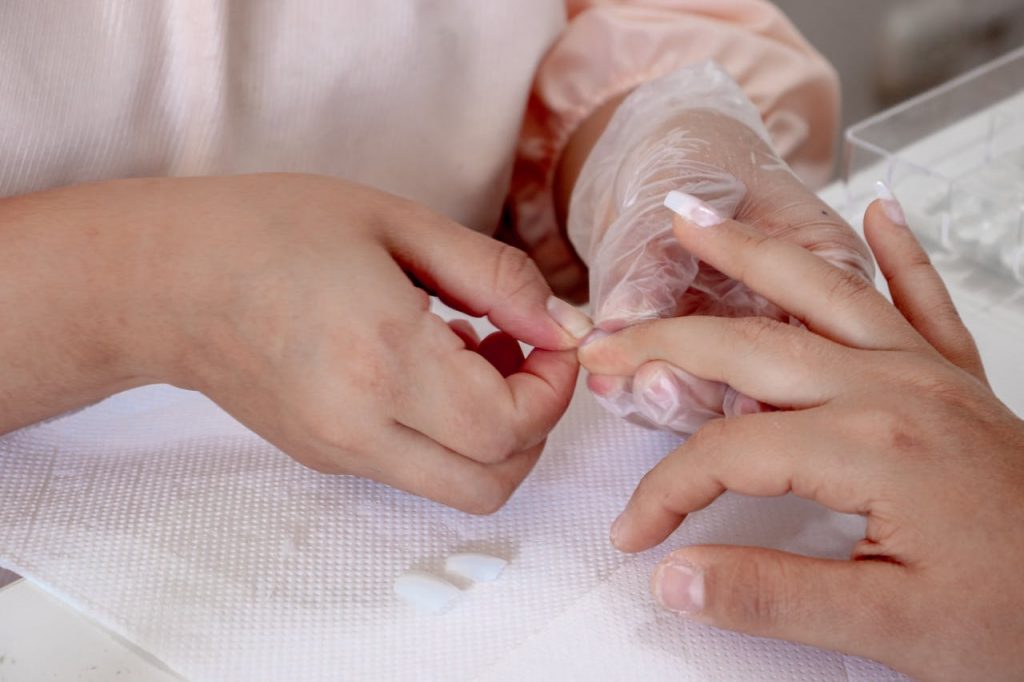The global artificial nails industry, including acrylic nails, has witnessed remarkable growth, valued at $274.0 million in 2022. This market is projected to expand at a compound annual growth rate (CAGR) of 5.7%, reaching an estimated $449.3 million by 2031.
This surge in popularity underlines the importance of understanding the origins and development of acrylic nails. From their invention to their role in contemporary beauty and fashion, the history of acrylic nails offers insights into how this beauty trend evolved into a significant component of the global beauty industry.
What are Acrylic Nails?
Acrylic nails are a popular cosmetic enhancement, designed to augment the appearance and strength of natural nails. These enhancements are known for their durability, offering a uniform and long-lasting manicured look that can last for weeks. The shape, length, and thickness of acrylic nails can be tailored to the wearer’s preferences, allowing for a wide range of styles and designs. Essentially, acrylic nails act as a protective layer over natural nails, often described as a ‘coat of armor’.
The core material for acrylic nails is a mixture of a powder polymer and a liquid monomer, typically ethyl methacrylate mixed with an inhibitor. When combined, this mixture forms a malleable bead that cures rapidly, solidifying in minutes to create the hard nail covers. This process results in acrylic nails that can last up to 21 days, with longer durability achievable through regular touch-ups. To add color, gel polish, nail polish, or dip powders can be applied over the acrylics.
Acrylic nails are a popular choice for concealing or repairing broken, damaged, short, or nails that are otherwise perceived as “undesirable.” They offer a solution to enhance the appearance of nails, providing a polished and flawless look. They can prevent nail biting, breakage, and splits, offering a solution for those unable to grow their natural nails to the desired length and strength, or for those seeking a new fashion look. This process utilizes various techniques such as nail tipping, sculptured nails, nail wrapping, and acrylic overlays. However, it’s important to note that improper removal of acrylic nails can damage the natural nails, hence the need for professional assistance during removal to ensure nail health.
When Were Acrylic Nails Invented?
Acrylic nails were initially conceptualized and created by dentists using dental materials. The earliest form of what would become modern acrylic nails dates back to 1934, invented by Maxwell Lappe, a dentist from Chicago. Lappe aimed to assist nail-biters by developing artificial nails. However, the significant breakthrough that shaped the acrylic nails we know today occurred in the 1950s. A notable figure in this development was Fred Slack, another dentist, who, after breaking his nail at work in 1954, made a fake nail using aluminum and dental acrylic. Slack and his family later patented this invention, marking the beginning of the commercial acrylic nail industry. In 1957, Slack further refined his invention, leading to the patent of the industry’s first nail form.
This innovation laid the foundation for the acrylic nails widely used in the beauty industry today. Their invention not only offered a solution for those looking to enhance the appearance of their nails but also played a pivotal role in shaping nail fashion and beauty trends over the ensuing decades.
Where Did Acrylic Nails Started?
The origin of acrylic nails can be traced back to a dentist’s office in 1957. Dr. Fred Slack, while working in his office, accidentally cut part of his thumbnail. Familiar with dental acrylics, used for repairing teeth, he utilized the same material to repair his nails. This incident not only led to the creation of the first acrylic nail extension but also sparked the development of modern acrylic nail technology. Slack’s innovative use of dental acrylic to fashion a realistic-looking nail extension marked the beginning of the acrylic nail industry.
This unconventional use of dental materials for cosmetic purposes laid the foundation for the widespread popularity of acrylic nails in the beauty and fashion industry. Dr. Slack’s pioneering work in the 1950s set the stage for the evolution of nail fashion, leading to the diverse array of acrylic nail styles and applications available today.
When Did Acrylic Nails Become Popular?
Acrylic nails gained widespread popularity in the 1970s and saw a significant rise in the 1980s. This surge in popularity was largely influenced by the fashion industry’s adoption of the trend, where acrylic nails became synonymous with style and glamour. Hollywood celebrities and figures in the entertainment industry played a pivotal role in popularizing long, artificial nails. This trend led to a marked increase in the number of salons offering acrylic nail services, catering to the growing demand for these fashionable nail enhancements.
The allure of acrylic nails has persisted over the years, with their lasting durability and the ability to easily change their design and shape, contributing to their enduring appeal in the beauty and fashion sectors.
The History of Acrylic Nails
As the concept of acrylic nails caught the interest of the beauty industry, it underwent significant evolution. Nail professionals began adopting and refining the techniques for aesthetic purposes. The 1970s marked a significant turning point, as Hollywood celebrities embraced acrylic nails, propelling them into the spotlight of glamour and style. This trend led to an explosion of nail salons offering acrylic nail services.
By the 1980s, acrylic nails were not just a fashion statement but also a canvas for creativity, with bright colors, fancy designs, and various shapes becoming popular. Over the years, advancements in technology and nail products have greatly improved the quality and versatility of acrylic nails. Today, they remain a popular choice for long-lasting nail enhancements, continuously evolving with new techniques, innovative products, and a wide range of designs
How Modern Acrylic Nails Were Created
The process of creating modern acrylic nails involves several steps. It starts with preparing the natural nails, ensuring they are clean and well-shaped. A primer is then applied to enhance adhesion. The acrylic itself is a blend of monomer liquid and polymer powder. This mixture is applied to the nails with a brush, sculpting and extending them to achieve the desired length and shape. A unique chemical reaction causes the acrylic to cure and harden, creating a strong and durable nail surface. The hardened acrylic is then shaped and polished to perfection. Nail polish or intricate nail art can be added to these acrylic bases for aesthetic appeal.
The evolution of acrylic nails was significantly influenced by the introduction of products and brands like CND and OPI in the 1980s. These brands offered a range of products that enabled more intricate designs and shapes. The use of new tools like airbrushes and UV lamps further enhanced the possibilities of acrylic nail art.
In the 1990s, the development of products like Bio Sculpture Gel and Shellac allowed for longer-lasting and more durable manicures. New tools, such as electric files and LED lights, enabled the creation of even more intricate designs. Today, acrylic nail technology has expanded into various artistic and creative realms. Salons offer services like 3D art, gel nails, and dipping systems, allowing for unique and eye-catching designs. There is now a wide range of products available to help users achieve the perfect nails, including specialized brushes, polishes, gels, and decorative stones.
This ongoing innovation in acrylic nail technology reflects a remarkable blend of science, creativity, and fashion. The influence of dental techniques in shaping and perfecting nail application has been crucial. Dentistry’s emphasis on cleanliness and safety has also been adapted to nail care standards. The collaboration between dentists and nail experts has led to more stylish, creative, and diverse nail designs. With advancements like CAD/CAM systems and 3D printing, the possibilities for unique nail art continue to grow, suggesting exciting developments for the future of nail fashion
How to Apply Acrylic Nails
Applying acrylic nails is a meticulous process that requires attention to detail and patience. Here’s a comprehensive guide on how to apply acrylic nails, covering every step from preparation to maintenance.
Applying acrylic nails involves a meticulous process, encompassing preparation, application, shaping, and maintenance. Each step requires specific tools and techniques for optimal results.
Preparation
- Cleaning and Prepping: Start by thoroughly cleaning your nails. Remove any old polish and make sure they’re free from oils and dirt.
- Cuticle Care: Gently push back your cuticles with a cuticle pusher, ensuring they’re off the nail bed for better adhesion of the acrylic.
- Buffing: Use a buffing block to gently remove the shine from your nails. This step is crucial for the acrylic to adhere properly.
Applying Nail Tips (Optional)
- Selecting Nail Tips: Choose nail tips that fit each nail snugly.
- Gluing: Apply a small amount of nail glue to the tip and then press it firmly onto your natural nail. Ensure it’s straight and well-attached.
- Shaping Tips: Trim the tips to your desired length and file them into shape. If there’s a ridge where the tip meets your natural nail, gently buff it to blend smoothly.
Priming
- Dehydrating the Nail: Apply a nail dehydrator to remove any remaining oils.
- Applying Primer: Use an acid-free nail primer over the entire nail bed to enhance the adhesion of the acrylic.
Applying the Acrylic
- Preparing the Mixture: Pour acrylic liquid into a dappen dish. Dip your brush into the liquid, then into the acrylic powder to form a ball.
- Application: Apply the acrylic mixture starting near the cuticle and spreading it evenly across the nail.
- Sculpting: Before the acrylic hardens, use your brush to shape it. Add additional layers as needed to achieve the desired thickness and look.
Shaping and Finishing
- Filing and Buffing: Once the acrylic has hardened, file your nails into your desired shape and buff the surface to smooth out any irregularities.
- Polishing: Paint your acrylic nails with your chosen nail polish and finish with a top coat for shine and protection.
Maintenance and Care
- Hydration: Regularly apply cuticle oil to keep the nails hydrated and prevent lifting.
- Regular Check-ups: Monitor your acrylics for lifting or damage. Avoid using them as tools and wear gloves for household tasks.
- Professional Intervention: If you notice any issues, seek professional help or remove the nails safely before applying a new set.
Removal
- Safe Removal: When removing acrylics, soak them in an acetone-based remover until they soften. Avoid forcing them off to prevent damage to your natural nails.
Key Tips
- Practice and Patience: Applying acrylic nails requires practice. Don’t get discouraged by initial imperfections.
- Aftercare: Proper aftercare is crucial for the longevity and health of your acrylic nails.
- Professional Assistance: If in doubt, consult a professional nail technician for application or removal.
- Gentle Handling: Be gentle when handling your acrylic nails. Avoid putting too much pressure on them, especially immediately after application.
- Avoid Moisture: After applying acrylic nails, keep your hands dry for a few hours to ensure the acrylic sets properly.
- Use Quality Products: Invest in high-quality acrylic liquids, powders, and primers. Good quality products not only last longer but also reduce the risk of nail damage.
- Regular Filing and Shaping: Regularly file your acrylic nails to maintain the desired shape and prevent them from becoming too long or unwieldy.
- Monitor Nail Health: Pay attention to the health of your natural nails. If you notice any signs of damage or infection, consult a professional.
- Proper Tool Maintenance: Keep your tools clean and sanitized. This prevents infection and ensures they work effectively.
- Breaks Between Applications: Give your natural nails a break between acrylic applications to allow them to breathe and recover.
- Stay Informed: Keep up-to-date with the latest techniques and products in acrylic nail application for the best results.
- Hygiene First: Always maintain good hygiene practices to prevent the risk of infections.
Conclusion
The history of acrylic nails is a testament to the continuous innovation and creativity driving the nail industry. From their humble beginnings as an accidental invention in a dentist’s office to becoming a global phenomenon, acrylic nails have come a long way. Today, they remain one of the most popular and versatile forms of nail enhancements worldwide. With advancements in technology and evolving fashion trends, there seems to be no limit to the possibilities for acrylic nails in the future. So, whether you’re a nail enthusiast or a professional technician, there’s always something new and exciting to discover in the world of acrylic nails! So go ahead, experiment with different designs and techniques, and create your unique style statement with acrylic nails! Happy styling!
Frequently Asked Questions
Who wore acrylic nails first?
The first wearers of acrylic nails were likely high-profile figures in Hollywood and the fashion industry in the 1970s.
Is it OK to wear acrylic nails for years?
Wearing acrylic nails for years is possible, but regular breaks and proper nail care are essential to maintain nail health.
What culture started nails?
Nail decoration and care originated in ancient cultures, with evidence from Chinese and Egyptian societies.
Do acrylic nails fall off?
Acrylic nails can fall off due to improper application, natural nail growth, or lack of maintenance.











